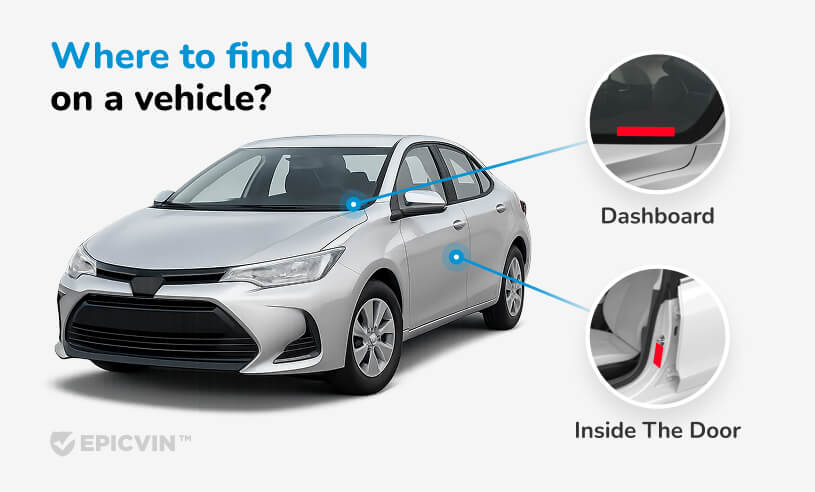
How to Read a VIN Number Like a Pro
From understanding the VIN number breakdown to uncovering a vehicle’s history,...

Free Lexus VIN Decoder! 🚗 See specs, build sheet, recalls basic history—no sign-up. 🛡️✅ Need accidents, mileage, title? Upgrade in one click.
Looking for the VIN?
Here is there you’ll find it:

A vehicle identification number serves as your Lexus car's digital fingerprint. The format was standardized in 1981. Such a sequence contains valuable information in capital letters and numbers. Our free VIN decoder instantly reveals factory specifications, recalls, and essential data to protect your investment before purchase.
Getting detailed vehicle information from your Lexus VIN takes just seconds with our decoder.

Your Lexus VIN appears in multiple locations for easy access and security purposes, blocked from unauthorized access but visible in these standard locations.
| Indicator | What It Means |
|---|---|
| Accident history percentage | ≈ 23% of EpicVIN reports on Lexus cars contain ≥ 1 damage record (accidents, body damage, etc.) |
| Salvage/Rebuild title | About 33% of Lexus vehicles on Copart have salvage or non-repairable status: serious frame/body damage |
| Average mileage | ≈ 110,000 miles for a Lexus over 10 years old. Luxury sedans average 10,961 miles yearly |
| Active 2025 recall campaigns | 8,300 cars: seat belt risk (NX/RX); 65 cars: airbag may not deploy (NX/RX); 10 cars: fuel pump engine shutdown (NX300/RX350L) |
Check the VIN before buying: nearly every fifth Lexus has recorded damage. EpicVIN checks help avoid unexpected repairs and unresolved recalls.
| Problem | Statistics and Issue Details |
|---|---|
| Fuel pump failure | Toyota/Lexus recalled ≈ 3.34 million cars due to a defective fuel pump: vehicles may suddenly stall while driving. The campaign covered the LS 460 and the RX 350 Lexus models. Dealers replace pumps free |
| Curtain airbag may not deploy (TX) | Recall 24LA05 affected ≈ 33,600 new Lexus TX models: the driver-side curtain may not work with the window down. Free module replacement performed |
| Damaged 2nd row seat belt (NX/RX) | Recall 25LA03 covered ≈ 8,400 NX/RX crossovers; the center belt could be plant-damaged and not withstand crash loads. Free inspection and replacement |
Note: Run the VIN through EpicVIN. Reports show whether the car fell under these mass campaigns or hides expensive repairs.

Each character in your vehicle's unique sequence tells a specific story:
Here's how our Lexus VIN decoder interprets a sequence example (JTJYARBZ2H2051612):
| Symbols | Sample | What It Reveals |
|---|---|---|
| 1 | J | Japan as the country of origin |
| 2 | T | Toyota as a manufacturer |
| 3 | J | Passenger car vehicle type |
| 4-8 | YARBZ | SUV body style, engine type, restraint system, RX model line, and trim level |
| 9 | 2 | Check digit for validation |
| 10 | H | 2017 model year |
| 11 | 2 | Cambridge, Ontario assembly plant |
| 12-17 | 051612 | Individual vehicle serial number |
Year 2003
Make Lexus
Model LS
Fuel Type Gasoline
Engine 4.3L V-Shaped 3UZ-FE
Made in JAPAN
Our decoder reveals comprehensive vehicle data from your Lexus VIN number.
Before you wire money for a pre-owned Lexus, drop the VIN into EpicVIN first. In seconds, you'll see the factory build sheet—whether it has Mark Levinson audio or the F SPORT package—plus any open fuel-pump or air-bag recalls, mileage rollbacks, and salvage or lien flags. Solid facts that can save you a fortune.Alex Black, CMO & auto expert, EpicVIN
Yes. EpicVIN lets you run a basic Lexus VIN decode at no cost—you'll instantly see build data such as model, engine, trim, plant, and year. You pay only if you decide to unlock the full vehicle-history report.
Absolutely. Enter the VIN in EpicVIN and review the "Recalls" section. We tap the NHTSA database in real time. So, any active Lexus service campaigns will show up with recall numbers and official notices.
Yes. Enter the Lexus VIN in EpicVIN. With our free VIN decoder, you'll instantly see core build specs, including model series, engine size, drivetrain, trim grade, paint code, and safety equipment generation.
Run the VIN through EpicVIN and open the Build Sheet section. We pull option and package data directly from Lexus/Toyota order banks and dealer feeds. For official PDFs, visit any Lexus dealership's parts desk.
EpicVIN's free Lexus VIN decoder aggregates data from authoritative sources, including state DMV & NMVTIS feeds, insurance databases, auction networks, and Lexus & NHTSA consulta vin Lexusrecall APIs for maximum accuracy and reliability.
Discover expert tips, news and advice on buying and maintaining used vehicles

From understanding the VIN number breakdown to uncovering a vehicle’s history,...

Read this article to discover about car registration.

Read this article to discover a lot of information about national insurance